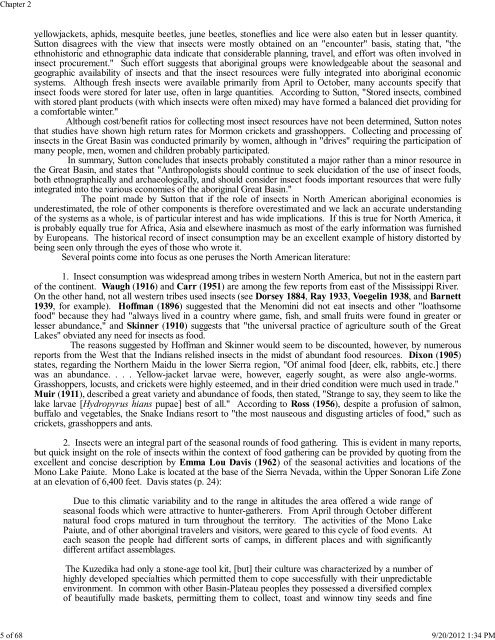Chapter 2. Insect Foods of North American Indigenous Populations ...
Chapter 2. Insect Foods of North American Indigenous Populations ...
Chapter 2. Insect Foods of North American Indigenous Populations ...
You also want an ePaper? Increase the reach of your titles
YUMPU automatically turns print PDFs into web optimized ePapers that Google loves.
<strong>Chapter</strong> 25 <strong>of</strong> 68 9/20/2012 1:34 PMyellowjackets, aphids, mesquite beetles, june beetles, stoneflies and lice were also eaten but in lesser quantity.Sutton disagrees with the view that insects were mostly obtained on an "encounter" basis, stating that, "theethnohistoric and ethnographic data indicate that considerable planning, travel, and effort was <strong>of</strong>ten involved ininsect procurement." Such effort suggests that aboriginal groups were knowledgeable about the seasonal andgeographic availability <strong>of</strong> insects and that the insect resources were fully integrated into aboriginal economicsystems. Although fresh insects were available primarily from April to October, many accounts specify thatinsect foods were stored for later use, <strong>of</strong>ten in large quantities. According to Sutton, "Stored insects, combinedwith stored plant products (with which insects were <strong>of</strong>ten mixed) may have formed a balanced diet providing fora comfortable winter."Although cost/benefit ratios for collecting most insect resources have not been determined, Sutton notesthat studies have shown high return rates for Mormon crickets and grasshoppers. Collecting and processing <strong>of</strong>insects in the Great Basin was conducted primarily by women, although in "drives" requiring the participation <strong>of</strong>many people, men, women and children probably participated.In summary, Sutton concludes that insects probably constituted a major rather than a minor resource inthe Great Basin, and states that "Anthropologists should continue to seek elucidation <strong>of</strong> the use <strong>of</strong> insect foods,both ethnographically and archaeologically, and should consider insect foods important resources that were fullyintegrated into the various economies <strong>of</strong> the aboriginal Great Basin."The point made by Sutton that if the role <strong>of</strong> insects in <strong>North</strong> <strong>American</strong> aboriginal economies isunderestimated, the role <strong>of</strong> other components is therefore overestimated and we lack an accurate understanding<strong>of</strong> the systems as a whole, is <strong>of</strong> particular interest and has wide implications. If this is true for <strong>North</strong> America, itis probably equally true for Africa, Asia and elsewhere inasmuch as most <strong>of</strong> the early information was furnishedby Europeans. The historical record <strong>of</strong> insect consumption may be an excellent example <strong>of</strong> history distorted bybeing seen only through the eyes <strong>of</strong> those who wrote it.Several points come into focus as one peruses the <strong>North</strong> <strong>American</strong> literature:1. <strong>Insect</strong> consumption was widespread among tribes in western <strong>North</strong> America, but not in the eastern part<strong>of</strong> the continent. Waugh (1916) and Carr (1951) are among the few reports from east <strong>of</strong> the Mississippi River.On the other hand, not all western tribes used insects (see Dorsey 1884, Ray 1933, Voegelin 1938, and Barnett1939, for example). H<strong>of</strong>fman (1896) suggested that the Menomini did not eat insects and other "loathsomefood" because they had "always lived in a country where game, fish, and small fruits were found in greater orlesser abundance," and Skinner (1910) suggests that "the universal practice <strong>of</strong> agriculture south <strong>of</strong> the GreatLakes" obviated any need for insects as food.The reasons suggested by H<strong>of</strong>fman and Skinner would seem to be discounted, however, by numerousreports from the West that the Indians relished insects in the midst <strong>of</strong> abundant food resources. Dixon (1905)states, regarding the <strong>North</strong>ern Maidu in the lower Sierra region, "Of animal food [deer, elk, rabbits, etc.] therewas an abundance. . . . Yellow-jacket larvae were, however, eagerly sought, as were also angle-worms.Grasshoppers, locusts, and crickets were highly esteemed, and in their dried condition were much used in trade."Muir (1911), described a great variety and abundance <strong>of</strong> foods, then stated, "Strange to say, they seem to like thelake larvae [Hydropyrus hians pupae] best <strong>of</strong> all." According to Ross (1956), despite a pr<strong>of</strong>usion <strong>of</strong> salmon,buffalo and vegetables, the Snake Indians resort to "the most nauseous and disgusting articles <strong>of</strong> food," such ascrickets, grasshoppers and ants.<strong>2.</strong> <strong>Insect</strong>s were an integral part <strong>of</strong> the seasonal rounds <strong>of</strong> food gathering. This is evident in many reports,but quick insight on the role <strong>of</strong> insects within the context <strong>of</strong> food gathering can be provided by quoting from theexcellent and concise description by Emma Lou Davis (1962) <strong>of</strong> the seasonal activities and locations <strong>of</strong> theMono Lake Paiute. Mono Lake is located at the base <strong>of</strong> the Sierra Nevada, within the Upper Sonoran Life Zoneat an elevation <strong>of</strong> 6,400 feet. Davis states (p. 24):Due to this climatic variability and to the range in altitudes the area <strong>of</strong>fered a wide range <strong>of</strong>seasonal foods which were attractive to hunter-gatherers. From April through October differentnatural food crops matured in turn throughout the territory. The activities <strong>of</strong> the Mono LakePaiute, and <strong>of</strong> other aboriginal travelers and visitors, were geared to this cycle <strong>of</strong> food events. Ateach season the people had different sorts <strong>of</strong> camps, in different places and with significantlydifferent artifact assemblages.The Kuzedika had only a stone-age tool kit, [but] their culture was characterized by a number <strong>of</strong>highly developed specialties which permitted them to cope successfully with their unpredictableenvironment. In common with other Basin-Plateau peoples they possessed a diversified complex<strong>of</strong> beautifully made baskets, permitting them to collect, toast and winnow tiny seeds and fine
















